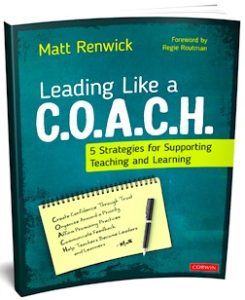Table of Contents
By Matt Renwick
In 2016 I bear in mind rifling by means of our English Language Arts standardized test outcomes and beginning to truly feel annoyed.
● The college students who need to have scored well performed decreased than envisioned.
● The learners who struggled in the earlier continued to battle.
● A couple pupils experienced not finished a section of a person of the tests.
Why isn’t our university improving? I puzzled. It’s not like we experienced failed to set objectives, or to interact in specialist studying, or to attempt to comprehend our students’ needs…and then I started to believe about what we did not know.
For case in point, could learners see how they ended up turning out to be better viewers and writers, further than what a examination score might suggest? Related, did the academics truly feel supported in this work? What was their point of view about experienced development toward continuous improvement?
I shut the binder of student test reports, not sure of our following steps.
Significantly less Certainty, Far more Inquiry
Due to the fact 2016 I have learned that tackling these sophisticated troubles requires permitting go of seeking to manage the results and functioning with certainty close to how to “fix” them.
What I needed was a better understanding of the obstacle alone by way of qualified inquiry. What has assisted us shift forward has been to split down the intricate troubles into smaller questions.
Crafting and pursuing these queries has led to improvement options that superior embrace the fact of the school society. Our strategies have been far more personalized and manufactured far more practical answers.
The next 20 inquiries have guided our perform you could locate them handy, far too.
How well do instructors belief their leadership and each and every other?
Belief is the basis for every thing that takes place in a faculty.
In the context of training, have confidence in can be described as the degree of self-confidence we have in every other and in our efforts to improve outcomes for college students. When rely on is existing, instructors and leaders speak both overtly and thoughtfully. There is tiny concern of damaging repercussions from administration or retribution from a near-minded colleague.
The next supplemental issues can assistance evaluate the degree of have confidence in in your school.
● Do we routinely engage in reliable and sincere dialogue?
● Do we stick to as a result of on our duties and commitments?
● Do we show compassion and caring for just one one more and our learners?
● Do instructors believe that they are producing a favourable impact?
How fully commited are we to a schoolwide priority?
The priority for a university should really describe the larger concentration for the business – for illustration, “support all pupils to turn out to be productive and engaged viewers.”
To be distinct, a objective is not a precedence. Aims are the expected outcomes that serve as indicators of calculated accomplishment towards a priority. Adhering to the example over, reading through accomplishment scores can be one goal, but they ought to not be made use of in isolation.
College surveys about experienced finding out, the share of college students obtaining intervention solutions heading up or down, and school library checkout costs can also give facts about this precedence.
The following more concerns can assist assess the amount of determination to your priority.
● Do we have a various set of details to support our targets and targets?
● Do instructors truly feel that experienced discovering is handy, applicable, and handy?
● Have we attained consensus about our beliefs and tactics for helpful instruction?
● What evidence do we have that learners are responding to our educational techniques?
How supported do teachers really feel in the classroom?
If we count on scholar mastering results to boost, leaders are clever to 1st make sure the ailments are favorable for academics to thrive.
This can be difficult to carry out when assets are scarce. There never ever appears to be adequate time, materials, or alternatives to collaborate with colleagues. Nevertheless, what can we do inside the constraints of our reality?
The subsequent additional issues can inform leaders to superior advocate for what is essential.
● Do we affirm the promising educational procedures instructors are presently working with?
● Is the school empowered to make conclusions about procedures and resources utilized in lecture rooms?
● Do teachers obtain common recognition in their endeavours to boost?
● Is the time academics have to fulfill on a regular basis and go over their get the job done safeguarded from outside the house influences?
Is continuous understanding a element of our faculty tradition?
Faculties are not compared with other businesses all techniques usually resist change.
This is the character of systems – they guide to results they are developed to generate. So to foster adjust in just the faculty tradition, it aids to have a dependable approach to skilled studying layout that pushes back again on systems and even enhances them.
Options for steady finding out abound: asynchronous on line courses, e-book reports, and professional understanding networks can all serve to support these initiatives.
And they really don’t have to be profound encounters. For illustration, I showed one particular-minute coaching films at the starting of employees conferences that shown how we can far better listen and answer through collaborative conversations with each and every other.
The next further thoughts can information leaders to assess the level of studying in just their faculty society.
● Do instructors know how to connect and get responses?
● Are leaders preventing information and concentrating a lot more on understanding our difficulties and responses?
● How do teachers and college students know they are on a pathway to achievements?
● Are all learners – pupils, lecturers, leaders – turning out to be superior at coaching on their own?
Dealt with collectively, one issue at a time, you can far better regulate the complexity of top universities towards achievements for both of those pupils and faculty.
Reward: To sustain this operate, consider reviewing these thoughts at least per year. Use this Google Doc template, 20 Inquiries to Better Understand Your Faculty, and truthfully respond to every single question as an training with your leadership workforce.

Matt’s latest guide, with a foreword by Regie Routman, is Leading Like a C.O.A.C.H. 5 Tactics for Supporting Training and Finding out (Corwin, 2022). You can subscribe to his common free Read by Instance newsletter (and take a look at the archives) at his web-site. Follow him on Twitter @ReadByExample.





More Stories
How a Masters in Teaching Positions You as an Educational Leader
The Benefits of Enrolling in Teaching Credential Programs
Elevate Your Career: Why an Online Teaching Degree is Your Next Step